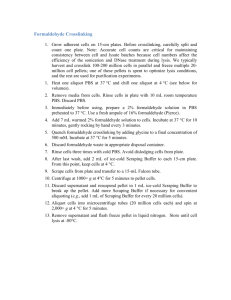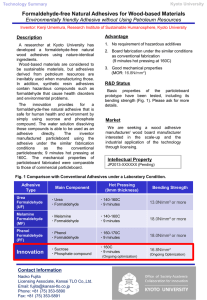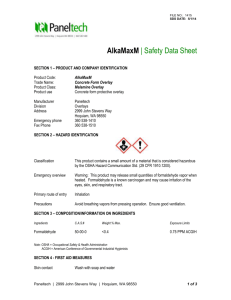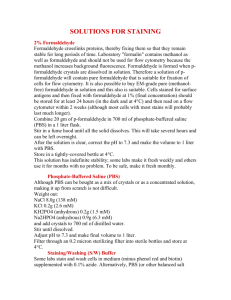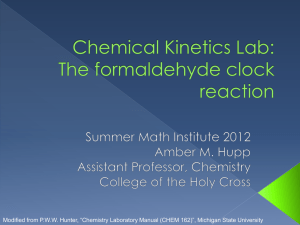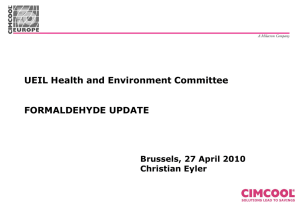JianongLi (127
advertisement
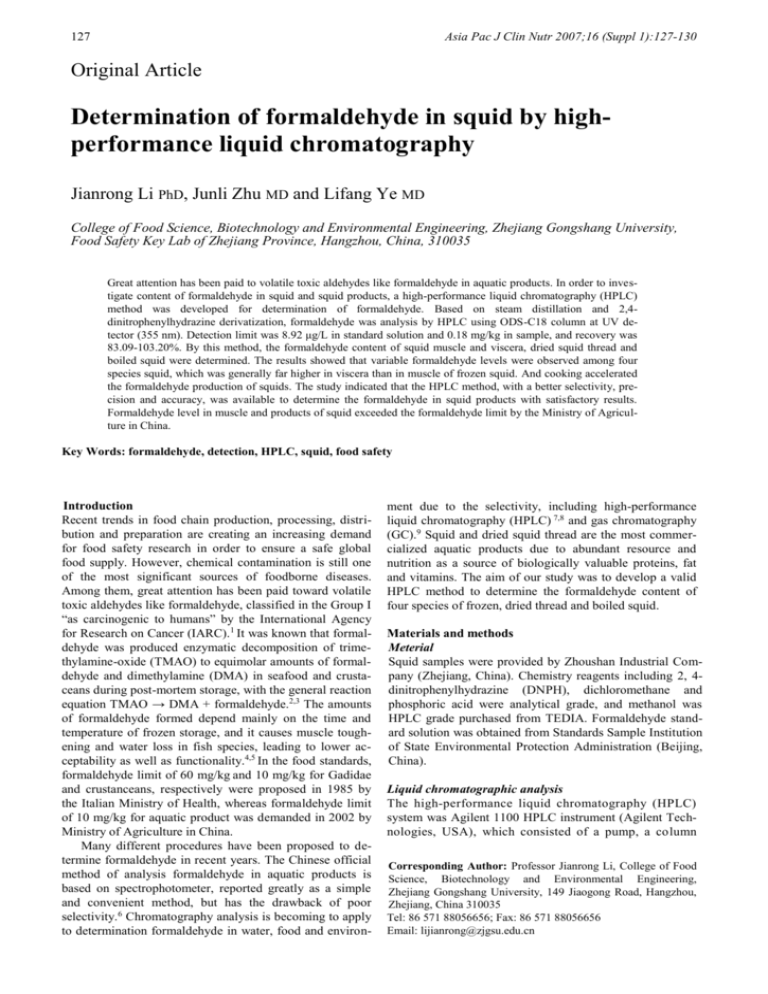
127 Asia Pac J Clin Nutr 2007;16 (Suppl 1):127-130 Original Article Determination of formaldehyde in squid by highperformance liquid chromatography Jianrong Li PhD, Junli Zhu MD and Lifang Ye MD College of Food Science, Biotechnology and Environmental Engineering, Zhejiang Gongshang University, Food Safety Key Lab of Zhejiang Province, Hangzhou, China, 310035 Great attention has been paid to volatile toxic aldehydes like formaldehyde in aquatic products. In order to investigate content of formaldehyde in squid and squid products, a high-performance liquid chromatography (HPLC) method was developed for determination of formaldehyde. Based on steam distillation and 2,4dinitrophenylhydrazine derivatization, formaldehyde was analysis by HPLC using ODS-C18 column at UV detector (355 nm). Detection limit was 8.92 μg/L in standard solution and 0.18 mg/kg in sample, and recovery was 83.09-103.20%. By this method, the formaldehyde content of squid muscle and viscera, dried squid thread and boiled squid were determined. The results showed that variable formaldehyde levels were observed among four species squid, which was generally far higher in viscera than in muscle of frozen squid. And cooking accelerated the formaldehyde production of squids. The study indicated that the HPLC method, with a better selectivity, precision and accuracy, was available to determine the formaldehyde in squid products with satisfactory results. Formaldehyde level in muscle and products of squid exceeded the formaldehyde limit by the Ministry of Agriculture in China. Key Words: formaldehyde, detection, HPLC, squid, food safety Introduction Recent trends in food chain production, processing, distribution and preparation are creating an increasing demand for food safety research in order to ensure a safe global food supply. However, chemical contamination is still one of the most significant sources of foodborne diseases. Among them, great attention has been paid toward volatile toxic aldehydes like formaldehyde, classified in the Group I “as carcinogenic to humans” by the International Agency for Research on Cancer (IARC).1 It was known that formaldehyde was produced enzymatic decomposition of trimethylamine-oxide (TMAO) to equimolar amounts of formaldehyde and dimethylamine (DMA) in seafood and crustaceans during post-mortem storage, with the general reaction equation TMAO → DMA + formaldehyde.2,3 The amounts of formaldehyde formed depend mainly on the time and temperature of frozen storage, and it causes muscle toughening and water loss in fish species, leading to lower acceptability as well as functionality.4,5 In the food standards, formaldehyde limit of 60 mg/kg and 10 mg/kg for Gadidae and crustanceans, respectively were proposed in 1985 by the Italian Ministry of Health, whereas formaldehyde limit of 10 mg/kg for aquatic product was demanded in 2002 by Ministry of Agriculture in China. Many different procedures have been proposed to determine formaldehyde in recent years. The Chinese official method of analysis formaldehyde in aquatic products is based on spectrophotometer, reported greatly as a simple and convenient method, but has the drawback of poor selectivity.6 Chromatography analysis is becoming to apply to determination formaldehyde in water, food and environ- ment due to the selectivity, including high-performance liquid chromatography (HPLC) 7,8 and gas chromatography (GC).9 Squid and dried squid thread are the most commercialized aquatic products due to abundant resource and nutrition as a source of biologically valuable proteins, fat and vitamins. The aim of our study was to develop a valid HPLC method to determine the formaldehyde content of four species of frozen, dried thread and boiled squid. Materials and methods Meterial Squid samples were provided by Zhoushan Industrial Company (Zhejiang, China). Chemistry reagents including 2, 4dinitrophenylhydrazine (DNPH), dichloromethane and phosphoric acid were analytical grade, and methanol was HPLC grade purchased from TEDIA. Formaldehyde standard solution was obtained from Standards Sample Institution of State Environmental Protection Administration (Beijing, China). Liquid chromatographic analysis The high-performance liquid chromatography (HPLC) system was Agilent 1100 HPLC instrument (Agilent Technologies, USA), which consisted of a pump, a column Corresponding Author: Professor Jianrong Li, College of Food Science, Biotechnology and Environmental Engineering, Zhejiang Gongshang University, 149 Jiaogong Road, Hangzhou, Zhejiang, China 310035 Tel: 86 571 88056656; Fax: 86 571 88056656 Email: lijianrong@zjgsu.edu.cn J Li, J Zhu and L Ye chamber, a VU detect, and an Agilent ChemStation for LC system. The HPLC column was a Hypersil ODS2-C18, 5μm, 200mm ×4.6mm. The sample volume was set at 20ul and the absorb wavelength of detector was set at 355nm. The mobile phase was methanol-water (60:40, v/v) with a flow rate of 1 ml/min. The peak area was used for quantitative calculation of formaldehyde. Sample derivatization and extraction The frozen squids were thaw at room temperature and samples were bagged and boiled at different temperature from 50-100℃ about 15min for boiled squid, then filleted, minced and homogenized. For determining the formaldehyde content, 10g mince sample, 200mL water and 10mL 10 percent weight phosphoric acid were mixed and distilled, then the distilling liquid was collected about 100mL. For extraction of the formaldehyde, 1 mL of distilling liquid was added into 0.5 mL of 1 mg/mL DNPH solution and then was extracted with dichloromethane. After vigorous mixed and dehydrated, dichloromethane was volatilized and was re-dissolved with 1mL methanol. The mixture was filtered through a 0.45um HV filter before injection. For each sample three replicates were analyzed. Results were expressed as mg of formaldehyde /kg. Calibration curve The formaldehyde work solution was diluted from 20 mg/L of formaldehyde stock solution, containing 0, 2, 5, 10, 15, 20 mg/L formaldehyde respectively. A 1 mL volume of each formaldehyde solution was derivatized and extracted according to described procedures. Three injections of each standard solution were made and the peak area was the corresponding formaldehyde concentration to obtain the calibration curve. Results and discussion The optimizations of derivatizing agent concentration, derivatizing time and derivatizing temperature were conducted between FA and DNPH reaction. Experiments revealed that when 20 mg/L of formaldehyde was determined, the peak area increased with 1.0 mg/mL of DNPH volume in the range of 0.1-0.5 mL, however, no more increased when DNPH exceed 0.5 mL (Fig 1). 128 Figure 2 showed the relationship between derivatizing time and area of formaldehyde at 60℃. Room temperature and 60℃ were chosen to derivatizing temperature. When 20 mg/L of formaldehyde and 1.0 mg/mL DNPH were reacted, the peak area increased with derivatizing time in the range of 5-15min at 60℃. However, with derivatizing time prolonged, peak area decreased. The derivation reached a stable state for 15min at 60℃, whereas reaction still did not complete for 25min at room temperature. Therefore, 0.5 mL of 1.0 mg/mL DNPH and derivatizing time for 15min at 60℃ were adopted as derivatizing condition in the following studies. Figure 3 showed chromatogram of formaldehyde standard solution by HPLC. Two main chromatographic peaks were found in the 4.5min and 7.9min respectively. Only one peak in 4.5min was appeared in blank solution, the other peak in 7.9min was considered to be a derivatized product of HCHO-DNPH in the formaldehyde standard solution. The calibration curve in the 0-20 mg/L range was obtained and correlation coefficient was 0.9996. The detection limit was 8.92 μg/L to the formaldehyde standard solution and 0.18 mg/kg to squid sample. The results of precision revealed that the R.S.D for two formaldehyde concentrations was 0.49% and 2.19%, respectively, when the formaldehyde standard solution of 10 mg/L and 20 mg/L was determined with 7 replicates each (Table 1). Figure 2. The relationship between derivatizing time and area of formaldehyde at 60℃ 1 2 Figure 1. The relationship between DNPH content and area of formaldehyde Figure 3. Typical chromatogram of formaldehyde standard solution. Peak identified as: (1) DNPH; (2) HCHO-DNPH 129 Determination of formaldehyde in squid Table 1. Experiments of precision by HPLC (n=7) concentration (mg/L) Area(mAU*S) average (mAU*S) Deviation RSDs (%) 10 6512 6527 6466 6473 6446 6526 6508 6494 32.1 0.49 20 12209 12394 12215 11993 12061 11554 12115 12077 264 2.19 Table 2. The recovery of HPLC in formaldehyde determination (n=3) Formaldehyde content of sample (mg/kg) 2.45 Adds standard solution (mg/kg) 2 5 10 15 20 Determined (mg/kg) 4.53 7.16 10.8 17.0 22.0 Recovery (%) 103 94.2 83.1 96.7 97.8 Table 3. Formaldehyde content in four species squids and dried squid thread FA (mg/kg) species Dosidicus gigas Japanese Ocean Ilex argentinus North Pacific Ocean muscle viscus Dried squid thread 17.3±1.62b 165±15.2b 35.3±1.92 10.7±0.16c 42.2±1.52d 34.4±0.81 19.7±0.58a 412±59.6a - 10.9±0.22c 119±11.2c - Values were given as mean ± SD form six determination. Different letters in the same column indicated significant differences (p<0.05). - Not determined Table 2 showed the recovery of HPLC in formaldehyde determination. Formaldehyde standard solutions, 2, 5, 10, 15, 20 mg/L were added the squid sample with 2.45 mg/L of formaldehyde. The average recoveries of this method were in the range of 80.09-103.20%. As general results, the method indicated good linear relationship, good selectivity, precision and accuracy in the determination of formaldehyde. The proposed method was applied to determine formaldehyde in four species of squids and products, Dosidicus gigas, Japanese ocean, Ilex argentinus, North pacific ocean. The results showed that variable formaldehyde levels were observed among four species squid, ever among different group samples of same specie, which was generally far higher in viscera than in muscle of frozen squid (Table 3). It could be explained both that TMAO levels differ from species and that TMAO reduction to DMA and formaldehyde is typically obtained by enzyme reaction.2,3 Some factors including squid dimension, feeding quality and fishing zone, are able to strongly influence the TMAO levels of squid. Furthermore, it was known that the reduction enzyme (TMAOase) is concentrated in the internal organs and red muscle, mostly in kidney and spleen.10, 11 Dried squid thread was popular to people all Figure 4. Variation of formaldehyde content in Dosidicus gigas muscle with the temperature from 50℃ to 100℃. Bars represented the standard deviation form triplicate determination. Different letters indicated significant differences among different treatments (p<0.05) over world, especially in Asia. The formaldehyde content of two kinds of squid thread was higher than 30 mg/kg, which exceeded the formaldehyde limit by Ministry of Agriculture in China (Table 3). Squid products are generally eaten after cooking, so Dosidicus gigas muscle was analyzed after different boiling temperature in order to evaluate the possible change in formaldehyde. An increase in the formaldehyde concentration was generally observed with the temperature rising, especially from 80℃ to 100℃ (Fig 4). The increasing phenomenon was surprising, in fact, high temperature quickened the volatilization of formaldehyde, which conferred that more formaldehyde may be produced.12 Actually, the more formaldehyde content in dried squid threads, involved in heat and boil processes, also showed that the cooking could accelerate the formaldehyde production.12,13 Some further studies about the production mechanism of formaldehyde will be carried out. In a conclusion, the study from the present data indicates that the HPLC method was available to determine J Li, J Zhu and L Ye the formaldehyde in squid and products with satisfactory results. Higher content of formaldehyde was found in viscera of squids, compared with in muscle and products, which exceeded the formaldehyde limit by Ministry of Agriculture in China, and cooking accelerated the formaldehyde production of squids. References 1. IARC. Monographs on the evaluation of carcinogenic risks to humans, vol 88, formaldehyde, 2-Butoxyethanol and 1-tert-Butoxy-2- propanol. Lyon, France: International Agency for Research on Cancer. 2004. 2. Phillippy BQ, Hultin, HO. Distribution and some characteristics of trimethylamine-n-oxide (TMAO) demethylase activity of red hake muscle. Food Biochem 1993;17: 235255. 3. Kimura M, Seki N, Kimura I. TMAOase, trimethylamineN-oxide demethylase, is a thermostable and active enzyme at 80℃. Fish Sci 2003;69:414-420. 4. Ang JF, Hultin HO. Denaturation of cod myosin during freezing after modification with formaldehyde. J Food Sci 1989;54:814–818. 5. Badii F, Howell NK. Changes in the texture and structure of cod and haddock fillets during frozen storage. Food Hydro 2002;16:313–319. 6. Zhou DQ, Ma JJ, Zeng MY. The assay and evaluation of uncertainty in the determintion of formaldehyde in aquatic procucts by spectrophotometer. Mar Fish Res, 2003;24:55-59. 7. 8. 9. 10. 11. 12. 13. 130 James JM. Improved measurement of formaldehyde in water-soluble polymers by high-performance liquid chromatography coupled with post-column reaction detection. J Chromatogr A 2001;914:123-129. Lin JF, Peng JF, Chi YG, Yu G, Jiang GB. Determination of formaldehyde in shiitake mushroom by ionic liquidbased liquid-phase microextraction coupled with liquid chromatography. Talanta 2005;65:705-709. Dojahn JG, Wentworth WE, Stearns SD. Characterization of formaldehyde by gas chromatography using multiple pulsed-discharge photoionization detectors and a flame ionization detector. J Chromatogr Sci 2001;39:54-58. Rehbein H, Schreiber W. TMAO-ase activity in tissues of fish species from the Northeast Atlantic. J Comp Biochem Physiol 1984;79B:447-452. Benjakul S, Visessanguan W, Tanaka M. Induced formation of dimethylamine and formaldehyde by lizardfish (Saurida micropectoralis) kidmey trimethylamine-Noxide demethylase. Food Chem 2004;84:297-305. Spinelli J, Koury BJ. No-enzymic formation of DMA in dried fishery products. Agr Food Chem 1979;27:11041108. Li JR, Zhu JL. The study on control of the formaldehydeproducing in the process techniques of Dosidicus gigas dried squid thread. J Chin Inst Food Sci Tech 2006;1:200203. J Li, J Zhu and L Ye 130
